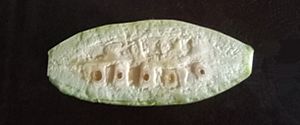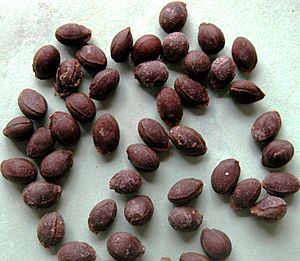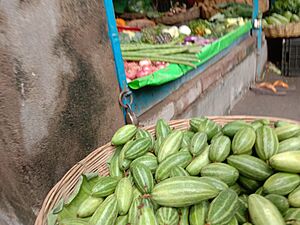Pointed gourd facts for kids
Quick facts for kids Pointed gourd |
|
|---|---|
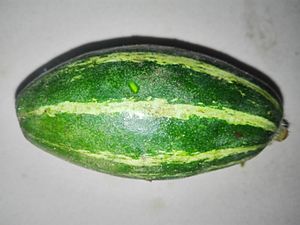 |
|
| gourd | |
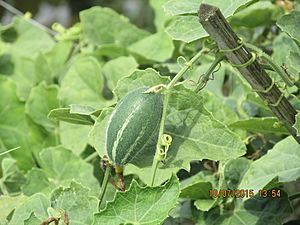 |
|
| gourd plants Raihan | |
| Scientific classification | |
| Genus: |
Trichosanthes
|
| Species: |
dioica
|
| Synonyms | |
|
|
Trichosanthes dioica, commonly known as pointed gourd, is a climbing plant. It belongs to the Cucurbitaceae family, which also includes plants like cucumber and squash. Unlike many plants in this family, the pointed gourd grows back every year.
This plant is a vine, meaning it climbs and spreads. It has heart-shaped leaves and is usually grown on a special frame called a trellis. The fruits are green and can have white stripes or no stripes at all. They can be small and round or long and thick, usually measuring about 2 to 6 inches (5 to 15 cm).
Pointed gourd grows best in warm and humid weather. It likes soil that is rich and drains water well, as it doesn't do well in soggy ground. The plant rests during the colder winter months.
Contents
Where Does Pointed Gourd Grow?
Pointed Gourd in India
In India, people often call this vegetable parval or green potato. It is grown a lot in the eastern and northern parts of the country. You can find it especially in places like Odisha, Bengal, Assam, Bihar, and Uttar Pradesh.
People in India use pointed gourd in many different ways. It can be an ingredient in soups, stews, and curry dishes. It's also used to make sweets or is eaten fried. A popular dish is potoler dorma or dolma, where the gourd is stuffed with things like fish, fish eggs, or meat. Another dish is kalonji, which is a deep-fried meal filled with spices.
Pointed Gourd in Bangladesh and West Bengal

In regions where Bengali is spoken, like Bangladesh and West Bengal, the pointed gourd is known as potol. It is a very important vegetable during the summer. Farmers grow it, and people eat it in every part of these regions. Since it's a perennial crop, meaning it grows back each year, it is often sold even in late October when other vegetables might be harder to find.
What Nutrients Does Pointed Gourd Have?
Pointed gourd is a healthy vegetable because it contains many important vitamins and minerals. It is a good source of carbohydrates, which give you energy. It also has vitamin A and vitamin C, which are important for your eyes and immune system.
This vegetable also contains important trace elements. These are minerals your body needs in small amounts to work properly. Some of these include magnesium, potassium, copper, sulfur, and chlorine. For example, 100 grams of the edible part of pointed gourd contains about 9.0 mg of magnesium and 83.0 mg of potassium.
Pointed Gourd in Culture
The pointed gourd has even been mentioned in old texts! In the fifteenth-century book Hatha Yoga Pradipika, which is about yoga, pointed gourd was listed as one of the foods that are good for people who practice yoga.


